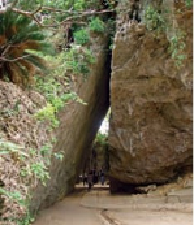Travel Reference
In-Depth Information
Seifa Utaki Shinto Shrine
Meaning “puriied place of Utaki,” this Shinto shrine dates from ime immemorial. Along with a few
gusuku
sites, it is one of only a handful of UNESCO World Heritage Sites on the island of Okinawa, or
in the whole of the Ryukyus. The Utaki sacred altars are located at one of the highest points on the
eastern end of the Chinen Peninsula. The overlook at these giant stones is of Kudakajima, which itself
is a holy place in Okinawan lore.
6
SEIFA UTAKI
斎場御嶽
If you have come to the Chinen Peninsula you'll find one of the island's very few non-
gusuku
UNESCO Heritage Sites. It's Seifa Utaki (
斎場御嶽
), the most sacred place in Okinawa. A le-
gend of the origin of the Ryukyus holds that the first of all gods, Tedako (god of the sun),
ordered two gods to land on the islands and organize them as nations. The legendary creator,
Amamikiyo (
アマミキヨ
), thereupon established sacred sites, one of which was Seifa Utaki.
Two great naturally split stone slabs form an upside-down V and mark the entrance to a pray-
er site that faces Kudakajima, the island of the gods' origin. Former royal rulers of Okinawa
used to visit Seifa Utaki every year to pray for a good harvest.
The site is high up on the Chinen bluffs, with a fine view of Nakagusuku Bay and Kudaka
Island. In former times, Seifa Utaki was closed to ordinary citizens; only royalty was permit-
ted to pass through the gates. There are six places of worship along a couple of well-marked
pathways. Because of its historical and cultural importance, it was designated a World Herit-
age Site by UNESCO in December 2000.


